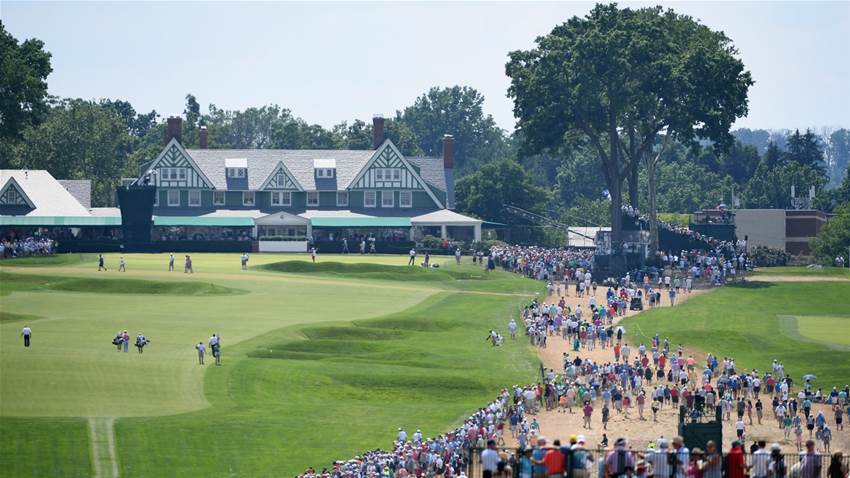It has forever been the most controversial of the four major championships. Especially when the topic of conversation is course set-up.
Outside of the Australian Open, in fact, the U.S. Open is the only Grand Slam event I can think of where the way in which the course is presented to the players is even an issue.
By way of example, no one ever talk about how Augusta National is set up for the Masters, much as the course is so much part of the occasion. Because the members tend to get just about everything right. At the Open - other than the infamous 1999 championship at Carnoustie when the rough was allowed to get out of control - the same is true, as it is at the PGA Championship.
But the U.S. Open is different, where the tradition is to make the course play as difficult as possible. To do that, you have to annoy people. And the United States Golf Association have certainly done that many times over the years. It’s not that hard, of course. Competitive golfers generally speaking don’t like things they can’t do.
Given how close the USGA like to get to the line between fair and unfair, there have been times when they have made mistakes. Which is understandable. If you are trying to get as close as you can to that line, it is inevitable that you will cross it now and then. I’m thinking of 2004 and 2018 at Shinnecock Hills on Long Island. On both occasions the green-speeds were basically out of control. And in 2002 at Bethpage Black there were holes where many players couldn’t actually reach fairways off the tee.
Anyway, when I first started playing in the U.S. Open (I made my debut at Olympic Fields in Chicago back in 2003) the course set-ups were pretty much the same. The fairways were typically 20-yards wide. The rough was so thick we had to chip-out. The greens were scary fast. So every shot that was even slightly ‘missed’ was punished disproportionately.
Things have changed since then though. When Mike Davis was in charge at the USGA, a new era emerged, starting at Winged Foot in 2006. How the difficulty was created was suddenly a bit more creative. And the championship has been a bit more interesting since.
Davis introduced graduated rough that got thicker the further you were from the fairway. Yes, that is a bit contrived, but the player who missed the fairway by one yard was always better off than the guy who missed by 15-yards. That makes sense. That second guy should be worse off. In tandem too, the USGA seems to take into account the different personalities of the courses to which they took the U.S. Open. The set-ups definitely took more account of each environment. Which was a big change from the days when the same philosophy was inflicted onto every course, no matter what.
My mind goes back to 2005 at Pinehurst No. 2. On a course where there really shouldn’t be any rough to speak of, the USGA grew long grass on either side of the fairways. In other words, they forced their traditional U.S. Open set-up onto a course wholly unsuited to that mind-set. Maybe that was why 2006 was when things changed.
Since then, the championship has been to Chambers Bay, where there was no rough. Short grass was the hazard that week (other than the really bad greens). Erin Hills was hard because it was so long. And when Pinehurst no. 2 returned in 2014, the fairways were wide and short grass was the hazard. Which is how that wonderful course is supposed to be.
Ironically, this year at Oakmont will see a return to what was for long enough the tradition set-up. But that is because that is how that course is best presented. The fairways will be narrow. The rough will be tough. The fairway bunkers will be one-shot penalties. And the greens will be lightning fast.
Now, when I first turned pro I was one of those who found that scenario incredibly annoying. To me, it was too restrictive. The risky and exciting recovery shot - one of golf’s most interesting aspects - was almost completely eliminated. In turn, that made it more difficult for the truly talented to separate themselves from the rest. Think of the shot Bubba Watson hit from the trees in the play-off he won at the Masters. Or the shot Rory McIlroy bent round the trees on the 15th at Augusta en route to his Masters victory this year. You don’t get to hit those at a traditional U.S. Open.

So it probably won’t surprise you to hear that I wasn’t in love with the U.S. Open, even when I won at Winged Foot in ’06. But over time I have come to appreciate it more. Maybe it is like what they say about political views. When you are young you are liberal; but as you get older you naturally become more conservative.
Whatever, I definitely appreciate the U.S. Open more than I used to. Golf cannot always be the Old Course at St. Andrews. We can’t always have 100-yard wide fairways that allow you to create your own angles into the greens. Every now and then, it is good to have an execution contest. Hit it here, then here, then here might not be the most interesting way to play and watch golf. But it is certainly a valid way to find the best player.
Look, I’m not saying that it’s okay for the USGA to go ‘over the top.’ As I said, things got silly at Shinnecock. When you are reduced to watering greens between groups and good putts are ending up in bunkers, then you know something has gone badly wrong. I mean, who can forget Phil Mickelson chasing his ball and stopping it from running off a green there in 2018? Nonsense.
Having said that, asking tough questions and punishing players severely when they fail to come up with an appropriate answer is okay with me. I have softened to that notion. I have warmed to it over the years. And it makes some sense in the modern game.
Towards the end of the last century the driver was the club over which players had the least control. Persimmon woods and balata balls was a tough combination. Now, however, just about every player on tour has way more control over the longest club in the bag. So, it makes sense to make finding short grass off the tee more difficult. Indeed, because driving is such a weapon in the modern game, punishing failure in that department has never made more sense.
So, take it from me, that is what you can expect when you sit down to watch the action at Oakmont. Level par won’t be too far from winning. And there is nothing wrong with such a scenario. That a traditional U.S. Open - the course firm and fast - still has a relevant place in the modern game is a good thing. Maybe a great thing.
Related Articles

Huggan: Is McIlroy the best European golfer of all time?

Column: Rory will grab the headlines but Portrush will steal the show













